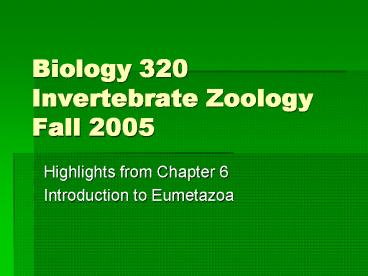Biology 320 Invertebrate Zoology Fall 2005 - PowerPoint PPT Presentation
1 / 11
Title:
Biology 320 Invertebrate Zoology Fall 2005
Description:
Biology 320 Invertebrate Zoology Fall 2005 Highlights from Chapter 6 Introduction to Eumetazoa What Defines an Animal? Irritability responds to external stimuli ... – PowerPoint PPT presentation
Number of Views:583
Avg rating:3.0/5.0
Title: Biology 320 Invertebrate Zoology Fall 2005
1
Biology 320Invertebrate ZoologyFall 2005
- Highlights from Chapter 6
- Introduction to Eumetazoa
2
What Defines an Animal?
- Irritability responds to external stimuli
- Locomotion
- Sense of direction
- Polarized distribution of organs
- Sponges are classified as Parazoa (near
animals) by some, and animals by others - Clearly metazoan
- Have unified distribution of cells
3
Eumetazoan Tissues
- All eumetazoans posses the four PRIMARY tissue
types, to some extent - Epithelium
- Connective tissue
- Muscle tissue
- Nervous tissue
- Epithelia that are more developed and diverse
than in parazoans - Has allowed organisms to colonize habitats that
are more physiologically challenging (i.e.
freshwater and terrestrial) - Increases compartmentalization in organisms
- Two main types (generally speaking)
- Epidermis barrier to external environment
which allows for homeostasis of internal
environment - Gastrodermis lines mouth and gut, and allows
for extracellular digestion
4
(No Transcript)
5
- Posses connective tissues
- Bind other tissues together
- Offer structural support - skeleton
- Types of skeletons
- Exoskeleton example insect cuticle
- Endoskeleton example sea urchin test
- Hydrostatic skeleton animal has a water-filled
cavity (i.e. gastrovascular cavity, coelom,
etc.). Muscle contractions displace water,
generating force that can be used to do work
6
- Eumetozoans posses musculature that allows them
to bend / turn while moving - Muscle types
- Smooth
- Cross-striated
- Obliquely striated
- Muscles are usually arranged in antagonistic sets
- One muscle moves body part one way, while the
other restores its original position - Human example biceps and triceps
- Tubular invertebrates longitudinal and circular
7
- Eumetozoans posses nervous systems
- Neurons evolved with muscle tissue
- Regulate muscle contraction so that animals can
respond to stimuli - Nerve impulses travel along membranes of axons
to effectors (target cells) - Important terms
- Motor unit
- Synapse
- Neurotransmitter
- Action potential
8
(No Transcript)
9
Sense Organs
- Animals must respond to stimuli in order to
survive - Three main classes of stimuli
- Electromagnetic energy mainly light
- Mechanical energy sound vibrations, touch,
pressure, gravity - Chemical stimuli taste, smell
- Animals must posses the appropriate receptors to
respond to these stimuli - Photoreceptors
- Mechanoreceptors
- Chemoreceptors
10
- Basic reflex arc
- Receptor
- Afferent signal
- Integration center (ganglion, CNS, etc.)
- Efferent signal
- Effector (target cell, organ, etc.)
- Many types of receptors throughout the animal
kingdom some are very simple and not considered
to be organs - Ocelli simple eyes that serve as photoreceptors
- Statocysts gravity / orientation receptors
11
Movement Vs. Body Size
- Smaller animals
- Often move using cilia
- Dont coast after stopping in water
- Friction overcomes momentum due to large SAVol
- Large animals
- Typically move using musculature
- Continue to move after stopping
- Smaller SAVol
- Surface area is correlated with drag, while
volume is correlated with musculature































